As one of my bucket list of places to visit, South Korea is a must place travel destination. This is actually my first international travel (I’m from the Philippines) and its a dream come true for me to travel this country. For this travel, we did a DIY trip and I would recommend it as you can actually budget your expenses and you can manage your own time or do your own itinerary of the exact places you want to visit.
UNDERSTANDING SOUTH KOREA
South Korea is a country in East Asia. The capital and largest city is Seoul. South Korea is a developed country and is home to Kpop, stunning Korean dramas & historical and beautiful places such as Gyeongbokgung Palace, Dongdaemun History and Culture Park, Jeju Island and N Seoul Tower. Its language is Hangul and there are 4 seasons in Korea.
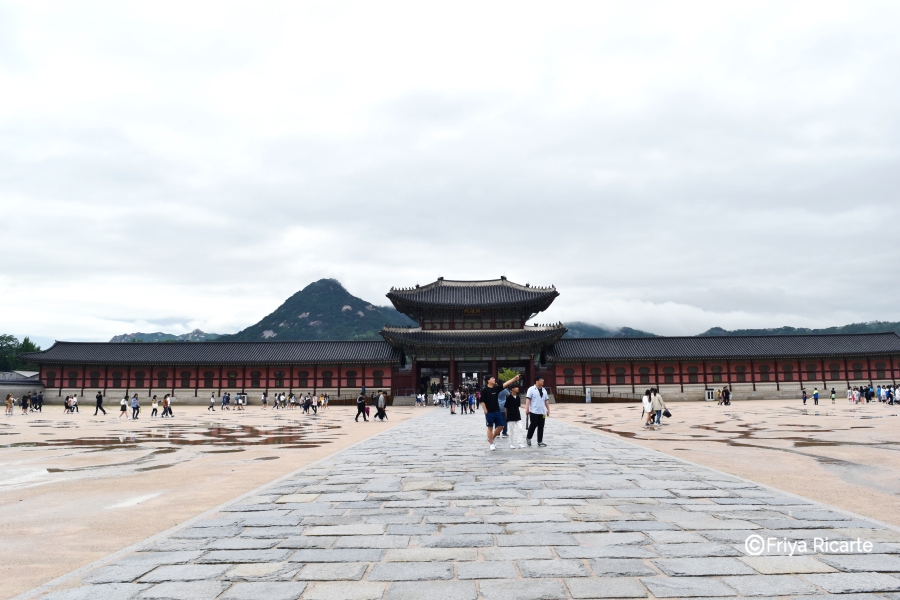
HOW TO APPLY FOR KOREAN VISA
Applying for Korean visa is easy as long as your requirements are complete. For a tourist visa, validity of visa is only 3 months from the issue date. You cannot apply more than 3 months prior to the date of travel. Applicants may file their applications at the Consular Office from 8:30 – 11:00 AM only.
VISA APPLICATION STEPS:
- COMPLETE THE NECESSARY REQUIRED DOCUMENTS
There are necessary visa requirements you need to complete and submit. I will be writing here the list of requirements for the application of single entry tourist visa for employed since that’s what I had applied for.
- Application Form
Accomplish the application form. The application form is also available when you go to the embassy but it is advisable to finish filling up the form before you go to embassy for less-hassle visa application.
You can download the application form here: Korean visa application form
- 1 piece of Passport size colored picture (Please attach on the application form)
- Original Passport (should be valid for more than 6months)
- Photocopy of Passport Bio-page (page 2)
- Original Certificate of Employment (must include applicant’s position, date hired, compensation, office address, HR landline number(cell-phone number is not allowed), HR e-mail address)
- Original Personal Bank Certificate (must include account type, current balance, account opening date, ADB)
- Bank Statement (original or certified true copy of bank statements/passbook for the last 3 months)
- ITR(Income Tax Return) or Form 2316 Copy and Company Alphalist (Form 1604 CF with BIR received stamp / please highlight your name)
The Company Alphalist (Form 1604 CF with BIR received stamp) was the latest addition to the visa requirement for tourist visa for first time travelers starting from March 26, 2018.
- Copy of PRC card or IBP card (if applicable only)
- Frequent travellers who have travelled as tourist to OECD member countries within 5 years are exempted from submitting ITR.
FOR SUPPORTING DOCUMENTS:
- If personally invited by a Korean
– Invitation letter
– Photocopy of invitor’s passport or identification card (authentication not required)
- If invited by company in Korea
– Invitation letter
– Photocopy of Korean Business Permit
For other category of visa requirements you can check the requirements here: Korean visa requirements categories
2. GO TO THE KOREAN EMBASSY AND SUBMIT YOUR VISA APPLICATION
Embassy of the Republic of Korea in the Philippines
Address: McKinley Town Center, 122 Upper McKinley Rd, Fort Bonifacio, Taguig, 1634 Metro Manila
Submit your visa application with the complete requirements to the Korean Embassy located as stated above. The visa application is available on Monday to Friday (working days) from 8:30 to 11:00 am only. It is advisable to arrive early to allow enough time for application process and also they accept applicants earlier than 8:30 am.
The visa application is a first come first serve basis. They don’t have an appointment for visa application. It is possible to let others submit your application. There specific windows in the embassy for application depending on your travelling type of application (e.g. for first time traveller, for those who had traveled to OECD countries, etc.)
VISA FEES:
- The visa is free (GRATIS) for 59 days (or less) stay in Korea.
- For 60 to 90 days stay in Korea there is a fee of ₱1,800.00
3. RETURN AND CLAIM YOUR PASSPORT AND VISA
Visa processing takes 5 working days for first time travellers, and 3 working days for frequent travellers. There is no expedite processing. Claiming of passport is from Monday to Friday from 1:30 to 4:00 PM only.
IMPORTANT REMINDER
The Korean embassy has announced that starting on July 1, 2018 visa application will be processed through designated travel agencies only due to increased number of Korean visa applicants.
The embassy has designated 35 travel agencies to process temporary visitor’s visa application. Starting from July 1, 2018, walk-in applicants for temporary visitor’s visa will no longer be accepted.
However, walk-in applicants is allowed only for spouses and children of Koreans, holders of visa issuance number, government employees with official business trip, and for those with humanitarian reason to travel to Korea urgently.
For the list of officially designated travel agency in for the processing of Temporary Visitor’s Visa: Official designated travel agencies for Korean visa application
TRANSPORTATION GUIDE IN SEOUL
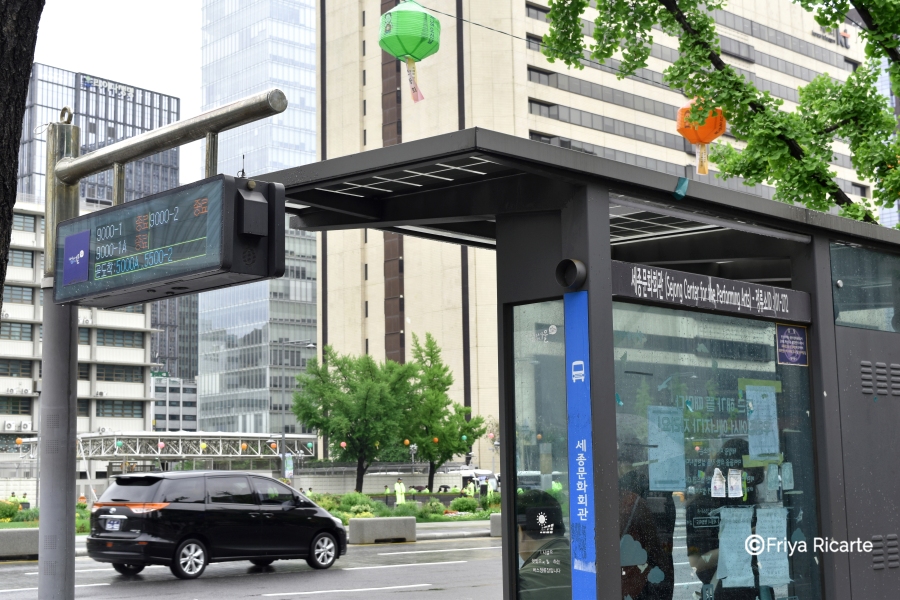
One thing you’ll love about Korea is that they have an organized system of transportation. From subways to buses, you will not have a hard time finding your way in Seoul.
There are 3 types of transportation in Korea that you can go with. Subway is the most common public transportation. There are also buses and taxis as means of transportation.
T-MONEY CARD
Getting around Seoul, you will be needing a T-money card. The T-money card is rechargeable series of smart cards used for paying transportation fares in and around Seoul and other areas of South Korea. T-money can also be used in lieu of cash or credit cards in some convenience stores and other businesses. It is very useful as it can also be use to pay on buses, taxis and other stores. In the Philippines it is almost equivalent to the Beep Card.
You can buy and reload the T-money card on convenience stores and can be reloaded on subway stations.
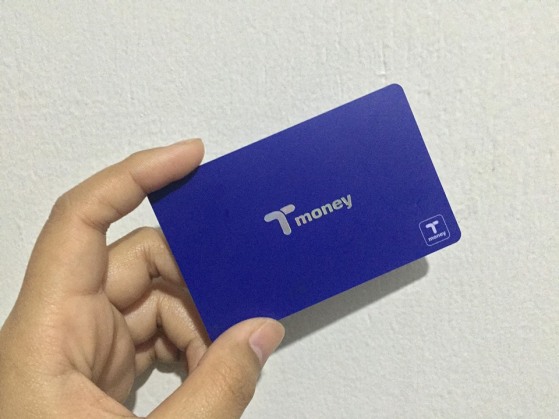
SUBWAYS
The Seoul Metropolitan Subway is the most easiest and convenient way of transportation. The network consists of numbered lines 1–9, which serve Seoul City proper and its surroundings and named regional railways that serve the greater metropolitan region and beyond.
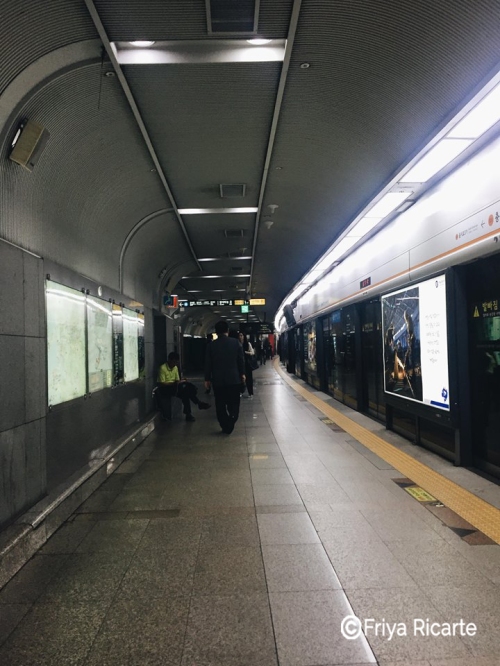
I would recommend you to download the app Subway Korea as it would help you learn to understand how the Subway works. There is a subway map provided and you can input where is your current station and the station you were heading to. It will give you directions on what subway. It has a real-time transit information which is really good as you would know when the train will arrive or how many minutes would it take you to the station you were heading to.
During my first time in the subway, it was actually confusing at first but once you get to it, it is simple and easy to learn.
CITY BUSES
The bus is another mean of transportation in Korea. It is reliable and probably the most inexpensive way of getting around Seoul. The buses has its own exclusive lane.
There are four types of buses in Seoul coded by colors Blue (trunk bus), Green (brunch bus), Red (rapid bus) and Yellow (circulation bus). Blue buses runs for longer distance and has access to median bus lanes connecting suburban areas to downtown Seoul. For green buses, it runs for shorter distance connecting major subway stations or bus terminals outside downtown Seoul. Red buses are designed especially for passengers commuting between downtown Seoul and the metropolitan area. While Yellow buses circulates on the circle parts of Seoul and stop at stations near business areas, tourist areas, and shopping areas. There are also route numbers on the buses to specify area divisions.
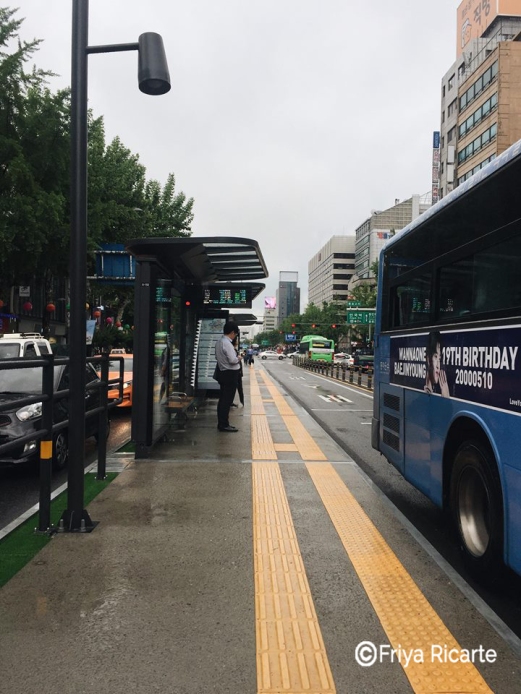
TAXIS
Many would not know but taxis in Korea are plentiful and relatively inexpensive. It is hassle free especially if you are going to a near area and carrying a lot of things. There are 2 types of taxis in Korea: the gray taxis (which can be also white and blue) and the deluxe or black taxis.
Regular taxi fares begin at W3000 (P148 / 2.78USD) in Seoul and increase by increments of W100 according to time/distance (every 142 meters), while deluxe taxies begin at W5000(P247 / 4.64 USD) and increase by W200.
FROM INCHEON INTERNATIONAL AIRPORT TO SEOUL
Arriving at the Incheon International Airport, it will greet you with its amazing structure. There are many ways to get through Seoul from the airport.
Airport Bus
There are 2 types of Airport buses: the standard and deluxe. It will both take you to Seoul Station. Tickets can be purchased at the ticket booths just outside the 1F Arrivals Hall of each terminal. You can ask your contact person of the hotel you are staying for the Airport bus number you should take to reach your accomodation.
Airport Railroad Express (AREX)
There are two trains that operates the Airport Railroad Express (AREX): the Express Trains and the All Stop Train. The Express trains runs from Incheon International Airport Terminal 1 and Terminal 2 directly to Seoul Station and the All Stop Train stops at 13 subway stations along the way from Incheon International Airport Terminal 2 to Seoul Station. The express train is the fastest way to arrive at Seoul.
- Express Train: Adults 9,000 won / Children 7,000 won
* Same fare applies for trains from Incheon Int’l Airport Terminal 2 Station. - – All Stop Train: Adults 4,150 won
* Fare from Incheon Int’l Airport Terminal 2 Station: 4,750 won
* Above fare is based on a standard one-time use transportation card (excluding 500 won refundable deposit). Deposit can be refunded at the arrival station.
Taxis
Upon arriving at the airport at 12:10 AM, the Airport buses and Airport Railroad Express (AREX) are no longer operating because it runs only starting at 5:30 AM to 22:00 PM. We had no choice but to take the Taxi from the Aiport to Insadong (which our hotel is located) that cost W60,000 (P2,956 / 55.75 USD). Taxis at the airport costs around W60,000 to W100,000 depending on the location you are heading to.
It is advisable to take the taxi if you carry a lot of baggage, your with children or with the elders. It is more comfortable and less tiring and hassle going to Seoul.
WHERE TO STAY IN SEOUL?
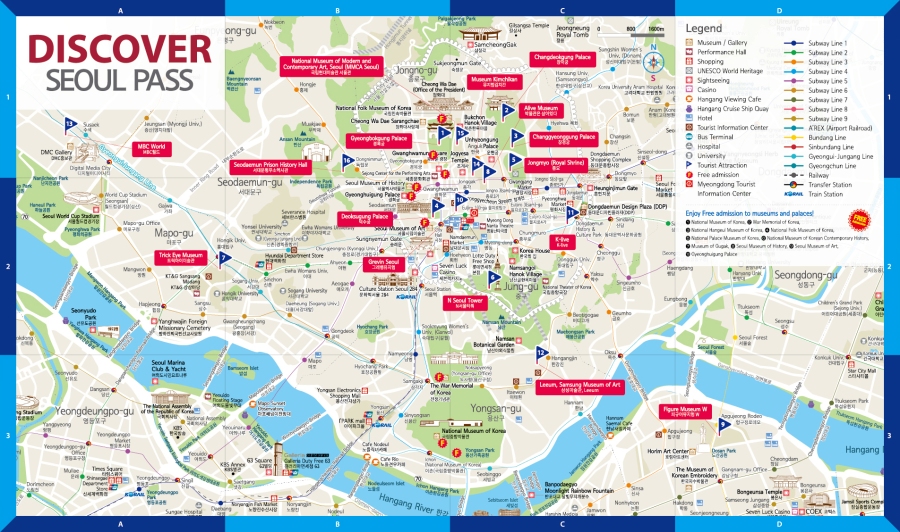
It is best to stay on a place that is near at the center of Seoul. The ideal location would be the one that is near the subway and restaurants.
Myeongdong is the most common place for tourist. It has lots of nearby hotels, restaurants, and shopping areas. This is also the place of lots of Korean skin care and beauty products. It has also a wide choices of Korean street foods. One thing that you must know about Myeongdong is that it more expensive than the other parts of Seoul since it is where most foreign tourist go, stays and shop. But the best thing about Myeongdong is that it has a variety of Korean restaurants, shopping centers and tourist spots.
Insadong of Jongno-gu district is the part of Seoul where we stay. We stayed at the Hotel Factory Insadong. It is a great hotel inn to stay because it’s near the restaurants, subways and bus stations, convenience stores, some tourist spots. I definitely recommend this if you’re doing a DIY trip since it is less expensive. The Hotel factory is just 10 mins away from the subway and 15-20 mins. away from Myeongdong by walking. Beside the hotel you would experience the typical Korean neighborhood. It has lots of affordable and cheaper restaurants that can only cost W5000 to W15000.
It is also great to find hotels near the Ehwa Woman’s University since it is much cheaper as it is a place for students. There are also lots of cheaper stores for clothing and beauty products.
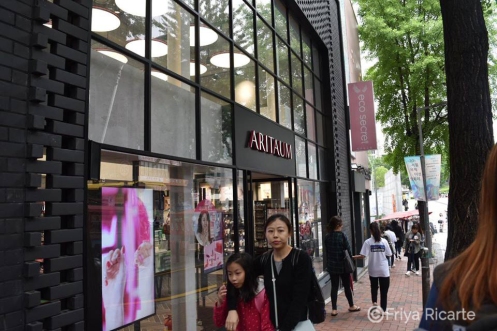
The best site/app to book your Hotel would be on Booking.com. It has a variety of hotels that you can choose. My advise for booking a hotel is that always look at its location in the map; how far it is from the subway or if there are near tourist spots and restaurants because it will save you a lot from expenses and travelling great distances.
SPRING IN KOREA
We went in Korea last May 15 – 22, 2018 in Korea and it is already in Spring time. During this time, the weather on our first two days in Korea was rainy. Then after two days becomes sunny though it is still chilly throughout the day. Daytime is more tolerable than the weather at night time. It is advisable to wear coats and jackets when roaming around at night while long sleeves or cardigans during daytime.
FOOD IN KOREA
There’s a lot of street foods that you can try out in Korea. There’s a street in Myeongdeong where you can buy and experience variety of street foods. Korean street foods starts at W2000. If you want to buy much cheaper street foods you can try it at Namdaemun.
There’s also a lot of local eateries where you can experience authentic Korean foods that is much cheaper compared to eating on expensive restaurants. There’s actually lots of local eateries on the street from our hotel. We just have to walk out and there’s a lot to choose without going too far and goingto restaurants that cost more. This is preferable if you want a cheaper and affordable price to buy foods but also taste good. This way you will also experience that way of Life of the Korean people.
Local eatery located at Namdaemun
Local eatery located at Insadong
KOREAN WORDS
There might be some few Korean words (Hangul) that might help you to communicate with the local people. Here are some greetings and introductions you can use while you were in Korea:
- Anyeong Haseyo! – Formal greeting that means “Hello/Good morning
- Ne – “Yes”
- Aniyo – “No” (formal)
- Kamsa Hamnida! – “Thank you”
- Je ireumeun____imnida – “My name is ____”
- _____ esuh watsuyo – “I’m from _____”
- jwoesonghandeyo – “Excuse me please” (formal)
- jwoesonghamnida – “Sorry” (formal)
- Ulmayeyo – “How much?”
I hope that I was able to give you some advice in travelling to South Korea. These are based on my experience when I went to Korea last May 2018. I will soon be posting my 7 days itinerary travel guide to Korea. Kamsahamnida!
























